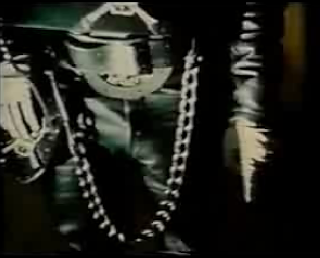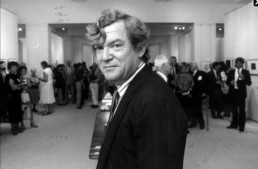
Unless you’re a serious film buff, you probably haven’t seen the work of. Kenneth Anger (below), whose short films have profoundly impacted cinema, advertising, and pop culture. Since 1947, when he was 17, he has been experimenting with difficult and obscure subject matter, using his own milieu as his inspiration, and his cast.

I first saw Scorpio Rising almost 30 years ago at the behest of my pal Madeleine Leskin, who went on to work at the Berlin Film Festival; she urged me into a late-night screening… I’ve never forgotten the disturbing/alluring quality of the film.

You’ll see Anger’s visual influence on later movies like Easy Rider (1969), Kathryn Bigelow’s The Loveless (1981), George Lucas’ American Graffiti (1973) and Martin Scorcese’s Mean Streets (1973). Specifically, his camera gazes adoringly at material objects, weighting them with an iconic, erotic power. Although never discussed as such, this camera work probably had it’s greatest impact on TV advertising! His films remain almost unknown to a broader audience, and ironically his book ‘Hollwood Babylon’ (1974), detailing the sordid underbelly of the movie industry, is his most famous work.

His movies are difficult, non-narrative, and certainly non-literal, almost dream-like (in fact the soundtrack of his ode to SoCal automotive culture, Kustom Kar Kommandos, is the Paris Sisters’ ‘Dream Lover’).

Scorpio Rising was completed in 1963, and its central character, Scorpio (Bruce Byron), is symbolic of the mythos of post-Wild One American Bikers. It’s hardly flattering, as he projects a homoerotic, sadomasochistic aura, snorting methamphetamines from a salt shaker, humiliating a man at a party, and defiling a church. Through jump shots to clips of other films (including The Wild One and a very bad black and white Jesus biopic), comic strips, and nazi imagery, Scorpio is alternately compared to Jesus, Hitler, and the Devil. Pop culture icons like James Dean and Lucky Strike cigarettes wallpaper the scenery.

It was considered obscene in the day, but now we’re all horribly jaded, and it merely seems shocking! Try to put yourself in the mindset of 1963 – Anger is a sly one and it’s difficult to tell if he’s celebrating Scorpio, or if he considers Scorpio a figment of a frightened citizenry’s imagination – everyone’s fantasy of what Bikers are Really Like. Using such imagery doesn’t constitute an endorsement!

Scorpio Rising is 28 minutes long, and requires a bit of patience; its an avante-garde piece by a filmmaker who is way out on a limb. It still has the best ‘title sequence’ of any biker film, hands down. With its great period soundtrack (referencing the action of course), it’s really the very first Music Video, predating the genre by a full 15 years, although no Music Video was ever quite like this again…




Amaaaaaaazing. Wow, seriously incredible. Now I see what you were talking about!! And awesome soundtrack too.
Wish you had been at his lecture, it was great, and he seems like the kind of man who is not just a creative genius, but someone that one must frequent the local hole in the wall pub with, for a good meal and a leisurely Belgian beer.
I can’t get “baby you’re torturing me” out of my head along with flashes of mustard, jesus, the nazi flag, leather, chains, elvis, scorpions, police sirens, riding across fields…
Amaryllis
Paul, in my fairly long life up to this point I thought I hadn’t missed much but this flew under my radar. You sir deal in the obsure. Thank you. Crazy Daddy O. Cool man, cool. Doc
i dont know if i can spell art skool tedious rite but i saw the film when it was new , thank god they turned the sound track down , nobody listened to that crap , chuck berry little richard jerry lee lewis et al the gays might have admired the rockers from afar but to lump them with this shirt tail lifter of a film is missing the point , i went to see rock around the clock and jail house rock , and the suede shoe boys had nothing to do with the rocker myth , and it was a myth , the only people that could afford to do the rocker myth were the fishermen of grimbsy they were the real teddy boys of the time , i guess its like the hippies of frisco a myth and we should not do lip service to it
Hmmm… I think Dave that you’re equating Rockers in England with American Bikers; different species, different bikes, different mentality. Bikers were thugs, doing drugs, raping and pillaging, in general having fun in a Viking sort of way. This film is very different than, say, The Leather Boys, although dealing with a similar subject. I could see your point re: tedium but I think the music is correct for ’63, and I’m certain that Kenneth Anger used his friends and their bikes to make this film – in a sense it’s probably much more true in terms of Who he is depicting than any other biker film – those are the guys, those are their bikes, that was what they wore and where they lived, that was a real party, although the action/narrative has been totally spiced up for the film and its crazy/profound/dreamlike images.
And regarding the gay thing; I think there is a lot more homoerotic tension in the whole leather/biker scene than most motorcyclists are comfortable discussing – Anger just made it very explicit. If you look at Danny Lyon’s book ‘The Bikeriders’ you’ll see a lot of similar action/sexual tension among the members of the Chicago Outlaws, but that book wasn’t made up – it was strictly documentary.
An interesting subject – this film actually changed a lot of people’s lives. My friend Dione saw it in ’63, and immediately started wearing what would become Punk clothing, later becoming part of a couple of Punk bands (‘Crass’ among them), but she was an elder stateswoman by then… talk about Early Adopters!
I was already a Punk when I saw the film! But it still blew my mind.
Thank you for this post!!
profond impact on kulture give me a fooking break thats art skool hip its stuff like that that calls the velvet underground cutting edge rock and roll obscure aint hip and the fact the “masses ” dont relate to but the art skool kids do aint hip
Dear Anonymous; they’re spelled ‘culture’, ‘school’, and ‘fucking’.
Inventing the Music Video seems pretty big to me, but maybe I watched too much MTV in the mid 80s…